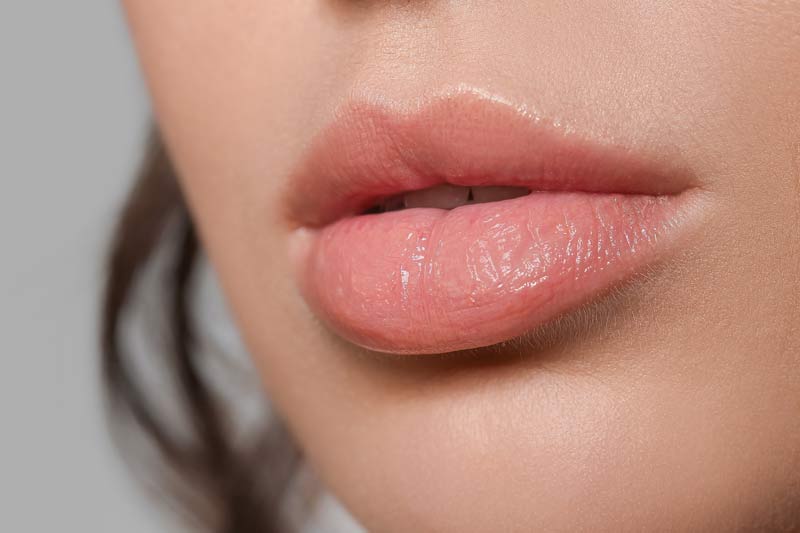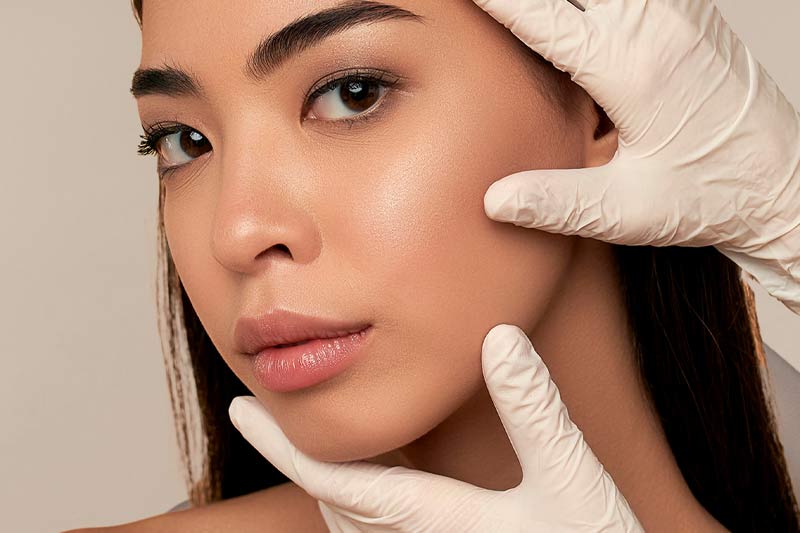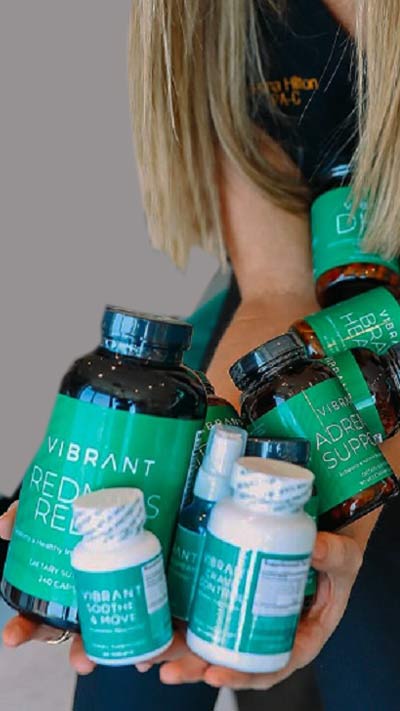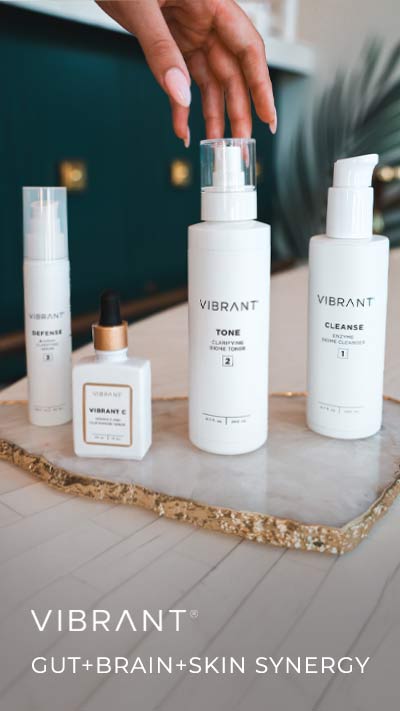Lip fillers are a popular cosmetic treatment hailed for their effectiveness and high safety profile. However, even though minimally invasive, this procedure is not entirely risk-free. Injected dermal filler can move from its designated site to other areas, creating a distorted look or lopsided features.
This article explains what causes lip filler migration, describes common symptoms, and provides effective treatment solutions.

What Is a Lip Filler Migration?
Lip filler migration, a relatively uncommon filler side effect, occurs when the product spreads unintentionally or moves away from its original location. It can migrate above the upper lip, to the inside of the lips, or below the borders. Sometimes it moves around the lip area, causing lumps or asymmetry.
Filler migration occurs more frequently in the lips than in other facial areas due to their constant movement and limited placement space.
Lip Filler Migration Symptoms
Recognizing the symptoms is vital for maintaining the desired aesthetic results and preventing potential complications. Note that what appears to be a lip filler migration may be just swelling, a common side effect that subsides within a few days.
The most common lip filler migration symptoms are the following:
- Less defined upper lip border (“the duck lip”)
- Puffiness above the upper lip (“lip filler mustache”)
- Blister-like spots on the inside of the lips
- One or both lips roll outward
- Stiff, rubbery lips
- Asymmetrical lips
- Uneven lips
- Pronounced contours
- Distorted contours
- Unnatural appearance
- Lumps and bumps
- Prolonged swelling
- Protruded lips
- Tenderness
- Numbness
- Difficulty moving the lips
How Often Does a Lip Filler Migrate?
Despite numerous alarming videos on social media, lip fillers do not migrate very often. This relatively rare side effect may happen if the dermatologist is inexperienced or poorly trained.
Research shows that the risk of migration is not exclusive to silicone fillers, but also extends to HA-based injectables. This potential outcome underscores the need for careful consideration and professional advice.
There is no guarantee that your filler will stay in place. Scheduling an appointment with a board-certified dermatologist will reduce the risk.
How Long After Treatment Can Lip Filler Migration Happen?
Lip filler migration can become visible within a few days or happen gradually as the product slowly breaks down and migrates to other areas due to muscle contractions.
Migration due to overfilling is typically visible immediately, while migration due to poor technique or frequent follow-up sessions might cause the filler to migrate after a few months.
What Causes a Lip Filler Migration?
Lip filler migration often occurs due to treatments performed by under-qualified injectors, though improper aftercare can also be the cause.
Below is a list of the most common factors that contribute to lip filler migration.
Poor Injection Technique
An unskilled provider may inject the filler too quickly or superficially, augmenting the features adjacent to the intended site or injecting the product into a lymphatic or blood vessel. Depositing the filler more slowly, using the micro-droplet technique, can minimize potential side effects and reduce migration risk.
Incorrect Placement
Injecting at the wrong angle or inserting the needle too deeply can distort the features by placing the product into the wrong tissue plane. Understanding different skin layers and knowing exactly how to insert the needle is vital, especially in the dynamic area of the lips.
Overfilling
Each filler has a unique capacity limit suitable for the lips. A poorly trained injector can exceed this limit, inject too much, or put filler on top of filler. Excessive volume can overstretch lip tissue, leading to uneven distribution, lumps, and even potential migration. A more subtle injection technique and smaller dosages prevent a bloated, puffy appearance.
Choosing an Unsuitable Filler
Administering an unsuitable filler increases the likelihood of migration. Lip fillers have different compositions, viscosity, and lifting capabilities. Each brand has a unique G prime rating based on consistency. Some are more malleable, watery, and elastic, while others are dense, sturdy, and firm. Low G prime fillers are more suitable for delicate areas such as the lips.
Ensure the provider is using trusted brands that are FDA-approved for lip augmentation and can be dissolved or easily reversed in case of an unwanted outcome. The most popular lip filler brands include Restylane (e.g., Kysse, Silk) and Juvéderm (Volbella, Ultra, Ultra Plus, Vollure).
Note: Read more about Juvéderm lip fillers and find out how long Juvéderm lasts in lips.
Applying Too Much Pressure
Filler practitioners usually apply gentle pressure or massage the area to help the filler settle and distribute evenly. However, the filler may shift if the injector applies too much pressure or uses abrupt movements. Patients should avoid pressing, squeezing, or rubbing the injected area to reduce the risk of filler displacement.
Inappropriately Spacing Follow-Ups
Frequent follow-up treatments increase the risk of filler migration and may lead to overcorrection. Placing filler on top of filler can cause the product to shift and migrate to unintended areas. Schedule a visit to monitor your lip enhancement, but avoid unnecessary adjustments that disrupt the healing process or trigger migration, swelling, or inflammation.
Disregarding the Patient’s Unique Features
Each procedure should be tailored to the patient’s unique facial features. The injector considers the lip tissue type, border definition, lip volume, and natural asymmetries in the lip area. Failure to address the patient’s unique facial anatomy can lead to uneven pressure and filler displacement.
Unexpected Physical Reaction
Each person reacts differently to filler treatments. Some may develop inflammation or start breaking down the hyaluronic acid too quickly, which can cause the filler to spread unintentionally. You can’t predict how your body will react to lip fillers, so there are no preventative measures that you can take to minimize this risk.
Natural Facial Movements
Repetitive facial movements such as smiling, pursing, talking, or eating can cause the filler to shift. Furthermore, the lips lack a firm support structure, which may contribute to filler spreading across the contours. Avoid excessive facial movements in the first few days following the treatment to reduce this adverse outcome.
Poor Aftercare
Not adhering to the aftercare protocol recommended by your medical practitioner may lead to side effects such as swelling, bruising, and migration. While most side effects are mild and temporary, migration may require professional assistance.
How to Avoid a Lip Filler Migration?
Taking appropriate precautions ensures lip filler stability and longevity. Here are the steps you can take to minimize the risk of filler displacement:
- Choose an experienced, board-certified provider who understands facial anatomy and can expertly perform the procedure using the appropriate filler brand.
- Adhere to lip filler aftercare guidelines to minimize the chances of bruising, swelling, and migration.
- Avoid making excessive facial movements in the days following the treatment.
- Botox lip flip limits movement in the area and can help reduce the risk of migration caused by excessive movement.
- Do not schedule follow-ups too frequently and allow the lips to heal before going for corrections.
- Have realistic expectations concerning the outcome since the results may vary from person to person due to factors such as facial structure, skin type, and metabolic rate.
Note: Did you know that lip fillers for men are a growing trend and provide numerous benefits?
How to Fix a Migrated Lip Filler?
There are several corrective measures that can effectively restore your desired aesthetic goal.
Schedule a Follow-Up Visit

Schedule a follow-up session for consultation and evaluation. The doctor may palpate the area to determine the issue’s severity and discuss the next step. Depending on the root cause and the severity of the symptoms, the doctor may suggest waiting for the filler to settle, applying gentle pressure, dissolving it with hyaluronidase injections, or reinjecting it.
Dissolve the Filler
Hyaluronidase injections dissolve lip fillers. However, only a medically-trained professional can safely perform the procedure to speed up hyaluronic acid breakdown in HA-based lip fillers. Liquid silicone injections can form nodules or granulomas that cannot be corrected or reversed.
Enzyme injections should be limited to areas with filler migration to ensure your natural hyaluronic acid volume remains unaffected. If you wish to refill your lips after having them dissolved, you should wait at least two weeks.
Gently Massage the Area
Applying light pressure using gentle circular motions on the migrated spot helps redistribute the filler. This should only be performed by a qualified injector who understands how to perform it safely and effectively.
Wait for the Filler to Settle
The lips need time to heal after the procedure. Allowing the filler to settle and integrate fully ensures that corrective actions are based on a stable outcome.
What Happens If You Do Not Treat Lip Filler Migration?
Lip filler migrations rarely cause serious complications. They typically lead to prolonged unwanted results. However, if left untreated, a poorly injected filler might migrate up the vasculature and cause vascular occlusion (i.e., a blood vessel blockage) and blindness.
Silicone injections cause migration more often than hyaluronic-based fillers. HA-based injectables are safer because they are temporary as the body slowly breaks down and metabolizes the filler.
It is necessary to correct migration before adding more filler, as not doing so can only worsen the effect.
Conclusion
Plump, well-contoured lips are an attractive look you can quickly achieve with fillers. Understanding how lip injections work and learning how to reduce side effects such as filler migration is essential. Once you are aware of the risks, the following step is to reach out to a team of experts who can enhance your lips in a safe medical setting.
Read the most frequently asked questions about lip fillers and contact our Vibrant Skin Bar filler experts with additional inquiries.


